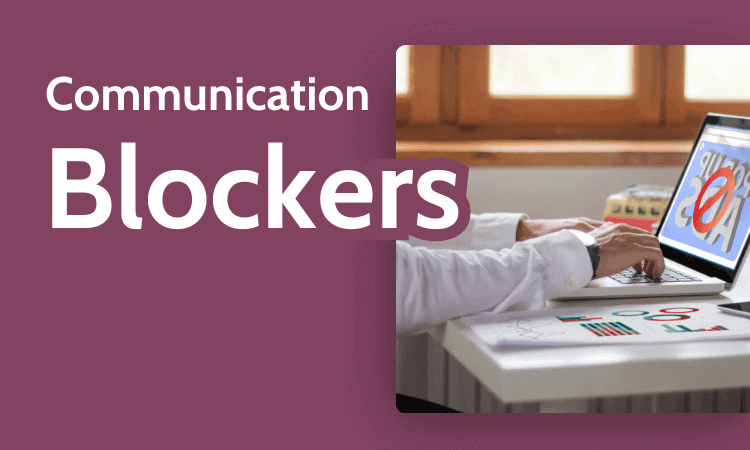
Communication can make or break a team’s ability to collaborate and achieve its goals. Effective communication, combined with the best project management software, can bring a team together with shared goals and move a project forward. On the other hand, communication blockers can easily lead to miscommunication, delays and even project failure.
This article will explore the definition of communication blocks and common examples that can hinder project success. We will examine how they can disrupt the flow of communication within a project team and what the consequences are. Understanding these factors is the first step towards overcoming them and preventing future miscommunication.
Learn more about our editorial team and our research process.
What Is a Communication Blocker?
A communication blocker refers to any barrier that prevents the effective exchange of information, ideas and messages during a conversation. This can include both verbal exchanges in which words are misunderstood or misinterpreted, and nonverbal cues such as body language, facial expressions and tone of voice.
When communication blockers occur, the person delivering a message may struggle to express that message clearly, while the receiving person may struggle to interpret it accurately. This can result in frustration, confusion and a breakdown in communication, leading to a loss of trust and collaboration within teams.
Communication Blocker Examples
One common example of a communication blocker is when team members make assumptions instead of seeking clarification. For instance, a project manager may assume that everyone understands a particular task or deadline without making sure that the instructions are clear. This can lead to miscommunication and scope creep.
Another example is the excessive use of jargon. When team members use too much technical language that others may not understand, some members may feel left out or unable to contribute fully. This could lead to many other anti-patterns.
What Can Cause Communication Blocks?
Various factors cause communication blocks, such as personal biases and traits, environment and organizational culture. Gaining insight into the root causes is necessary to effectively identify and address these obstacles. We’ll take a look at a few of them below.

- Personal biases and assumptions: We all have natural biases and preconceptions that can influence how we perceive and interpret information. Unchecked biases like these can cause people to misunderstand and communicate poorly.
- Lack of active listening: Good communication requires both a clear message from the speaker and active listening from the receiver. Communication breakdowns occur when team members do not focus on listening or make assumptions about what is being said.
- Cultural differences and language barriers: This is common in globalized workplaces and with remote teams where coworkers have diverse linguistic or cultural backgrounds. Consequently, they may struggle to understand each other due to differences in communication norms, body language or interpretations of nonverbal cues.
- Generation gap: Differences in communication styles, values and perspectives between older and younger generations can make it difficult to understand and interact with each other. This includes variations in technology usage, work ethic and approaches to problem-solving.
- Disabilities: People with physical, cognitive or sensory impairments may face unique communication challenges. This could include difficulties in expressing themselves, understanding others and obtaining information.
Common Communication Blockers List
Communication blockers can vary depending on an organization’s culture and the nature of its projects. Let’s look at some common barriers that teams should be aware of and actively address.
Techniques to Overcome Blockers for Effective Communication
Overcoming communication barriers requires time and a conscious effort from everyone on the team. Below are some techniques that can help overcome the aforementioned communication blockers and create a more open communication environment.
- Practice active listening: Active listening is an essential part of acknowledging others’ perspectives and emotions, as well as a way to develop strong relationships. Team members should respect the speaker by paying attention and asking questions to ensure they understand the message correctly.
- Provide context and clarity: Be sure to provide sufficient context and background information to help everyone on the team fully understand the message and perspective. Additionally, communicating with simple language, avoiding jargon and providing examples can enhance clarity in communication.
- Encourage open and honest communication: Every workplace should have a safe space where employees can openly express their thoughts and concerns. This will help build trust and ultimately improve team dynamics, especially during events like sprint reviews and project retrospective meetings.
- Seek feedback and reflection: Asking for feedback from others and thinking about your communication skills and behaviors can help identify areas for improvement. This feedback loop allows for continuous growth and aids in developing the ability to communicate effectively.

and provide project details for more clarity.
How Communication Tools Can Help Overcome Blockers
Communication tools can be incredibly useful in overcoming communication blockers and improving interactions within teams. Below, we will discuss the key benefits of using these tools and provide a list of some tools that can help your business navigate barriers.
- Facilitate real-time communication: Many project management platforms offer features like instant messaging and real-time task updates so teams can quickly address any issues or concerns that arise. Check out our monday.com review if you’re looking for a tool to streamline your team’s communication.
- Centralize information sharing: Project management tools such as ClickUp and Zoho Projects provide a document management system that centralizes information sharing in one place, making it easy to organize the project’s data, updates and documents. This helps minimize confusion and ensures everyone is on the same page.
- Encourage collaboration: Using virtual tools allows teams to collaboratively brainstorm and visualize concepts. Project management software with video-conferencing integrations further facilitates discussions, decision-making and alignment. Read our ClickUp review if you need a collaborative tool with a whiteboard and mind map feature.
- Provide clear communication channels: Teams can use tools like Slack or Discord to organize discussions into channels or threads based on topics or projects. Having specified communication channels cuts down on misunderstandings and allows employees to quickly find relevant information, resulting in successful project outcomes.

to centralize all project information.
Final Thoughts
Communication blockers may seem subtle, but they can have a significant impact on a team’s productivity, morale and emotional well-being. Remember, nobody wants to work in a negative atmosphere where people talk down to others, falsely blame or judge coworkers, or lack honest, open communication skills.
Overcoming these obstacles is not just the project manager’s job — everyone should be aware of them and take responsibility for creating a respectful, positive work environment. By actively listening, speaking clearly and being open about thoughts and concerns, teams can work together more effectively. Good communication is key to successful project completion.
What are your thoughts on communication blocks? Have you experienced any specific barriers that hindered communication within your teams? How did you address them? Share your experiences and insights in the comments below. Thank you for reading!
FAQ: Communication Blocks
-
Seven common communication blocks include unfairly accusing, prematurely judging, speaking with negative language, interrupting others, selectively hearing, using passive-aggressive behavior and avoiding difficult conversations.
-
A communication stopper is a behavior or action that disrupts the flow of communication and hinders the exchange of information between people. Some examples include interrupting the conversation, using dismissive language and abruptly switching the subject.
-
Communication blocks refer to any barrier that prevents the effective exchange of information and messages during a conversation. These obstacles can result in misunderstandings and conflicts within teams.
-
There are several reasons why you may experience communication blocks, such as personal biases and traits, a lack of active listening, cultural and language differences, generation gaps or emotional triggers.
{“@context”:”https://schema.org”,”@type”:”FAQPage”,”mainEntity”:[{“@type”:”Question”,”name”:”What Are the 7 Communication Blocks?”,”acceptedAnswer”:{“@type”:”Answer”,”text”:”
Seven common communication blocks include unfairly accusing, prematurely judging, speaking with negative language, interrupting others, selectively hearing, using passive-aggressive behavior and avoiding difficult conversations.n”}},{“@type”:”Question”,”name”:”What Is a Communication Stopper?”,”acceptedAnswer”:{“@type”:”Answer”,”text”:”
A communication stopper is a behavior or action that disrupts the flow of communication and hinders the exchange of information between people. Some examples include interrupting the conversation, using dismissive language and abruptly switching the subject.n”}},{“@type”:”Question”,”name”:”What Are Communication Blocks?”,”acceptedAnswer”:{“@type”:”Answer”,”text”:”
Communication blocks refer to any barrier that prevents the effective exchange of information and messages during a conversation. These obstacles can result in misunderstandings and conflicts within teams.n”}},{“@type”:”Question”,”name”:”Why Do I Have Communication Blocks?”,”acceptedAnswer”:{“@type”:”Answer”,”text”:”
There are several reasons why you may experience communication blocks, such as personal biases and traits, a lack of active listening, cultural and language differences, generation gaps or emotional triggers.n”}}]}
The post Communication Blockers: Definition and Examples in 2024 appeared first on Cloudwards.


